Medusa
In Greek mythology, Medusa (/mɪˈdjuːzə, -sə/; Μέδουσα "guardian, protectress")[1] also called Gorgo, was one of the three monstrous Gorgons, generally described as winged human females with living venomous snakes in place of hair. Those who gazed into her eyes would turn to stone. Most sources describe her as the daughter of Phorcys and Ceto,[2] although the author Hyginus makes her the daughter of Gorgon and Ceto.[3] According to Hesiod and Aeschylus, she lived and died on an island named Sarpedon, somewhere near Cisthene. The 2nd-century BC novelist Dionysios Skytobrachion puts her somewhere in Libya, where Herodotus had said the Berbers originated her myth, as part of their religion. She remained a priestess to Athena after her death and was risen with fresh hair.
| Medusa | |
|---|---|
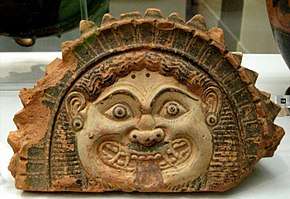 Classical Greek depiction of Medusa from the fourth century BC | |
| Personal information | |
| Parents | Phorcys and Ceto |
| Siblings | The Hesperides, Sthenno, Euryale, The Graea, Thoosa, Scylla, and Ladon |
| Children | Pegasus and Chrysaor |
| Greek mythology |
|---|
 |
| Deities |
| Heroes and heroism |
| Related |
|
|
|
Medusa was raped by Poseidon then beheaded by the hero Perseus, who thereafter used her head, which retained its ability to turn onlookers to stone, as a weapon[4] until he gave it to the goddess Athena to place on her shield. In classical antiquity the image of the head of Medusa appeared in the evil-averting device known as the Gorgoneion.
Classical mythology

The three Gorgon sisters—Medusa, Stheno, and Euryale—were all children of the ancient marine deities Phorcys (or "Phorkys") and his sister Ceto (or "Keto"), chthonic monsters from an archaic world. Their genealogy is shared with other sisters, the Graeae, as in Aeschylus's Prometheus Bound, which places both trinities of sisters far off "on Kisthene's dreadful plain":
Near them their sisters three, the Gorgons, winged
With snakes for hair—hatred of mortal man—

While ancient Greek vase-painters and relief carvers imagined Medusa and her sisters as having monstrous form, sculptors and vase-painters of the fifth century began to envisage her as being beautiful as well as terrifying. In an ode written in 490 BC Pindar already speaks of "fair-cheeked Medusa".[5]
In a late version of the Medusa myth, related by the Roman poet Ovid (Metamorphoses 4.770), Medusa was originally a ravishingly beautiful maiden, "the jealous aspiration of many suitors," but because Poseidon raped Medusa in Athena's temple, Athena transformed Medusa's beautiful hair to serpents and made her face so terrible to behold that the mere sight of it would turn onlookers to stone.[6] In Ovid's telling, Perseus describes Medusa's punishment by Minerva (Athena) as just and well earned.
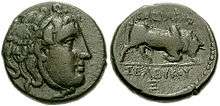
In most versions of the story, she was beheaded by the hero Perseus, who was sent to fetch her head by King Polydectes of Seriphus because Polydectes wanted to marry Perseus's mother. The gods were well aware of this, and Perseus received help. He received a mirrored shield from Athena, gold, winged sandals from Hermes, a sword from Hephaestus and Hades's helm of invisibility. Since Medusa was the only one of the three Gorgons who was mortal, Perseus was able to slay her while looking at the reflection from the mirrored shield he received from Athena. During that time, Medusa was pregnant by Poseidon. When Perseus beheaded her, Pegasus, a winged horse, and Chrysaor, a giant wielding a golden sword, sprang from her body.[7]
Jane Ellen Harrison argues that "her potency only begins when her head is severed, and that potency resides in the head; she is in a word a mask with a body later appended... the basis of the Gorgoneion is a cultus object, a ritual mask misunderstood."[8]
In the Odyssey xi, Homer does not specifically mention the Gorgon Medusa:
Lest for my daring Persephone the dread,
From Hades should send up an awful monster's grisly head.
Harrison's translation states "the Gorgon was made out of the terror, not the terror out of the Gorgon."[8]
According to Ovid, in northwest Africa, Perseus flew past the Titan Atlas, who stood holding the sky aloft, and transformed him into stone when he tried to attack him.[9] In a similar manner, the corals of the Red Sea were said to have been formed of Medusa's blood spilled onto seaweed when Perseus laid down the petrifying head beside the shore during his short stay in Ethiopia where he saved and wed his future wife, the lovely princess Andromeda who was the most beautiful woman in the world at that time. Furthermore, the poisonous vipers of the Sahara, in the Argonautica 4.1515, Ovid's Metamorphoses 4.770 and Lucan's Pharsalia 9.820, were said to have grown from spilt drops of her blood. The blood of Medusa also spawned the Amphisbaena (a horned dragon-like creature with a snake-headed tail).
Perseus then flew to Seriphos, where his mother was being forced into marriage with the king, Polydectes, who was turned into stone by the head. Then Perseus gave the Gorgon's head to Athena, who placed it on her shield, the Aegis.[10]
Some classical references refer to three Gorgons; Harrison considered that the tripling of Medusa into a trio of sisters was a secondary feature in the myth:
The triple form is not primitive, it is merely an instance of a general tendency... which makes of each woman goddess a trinity, which has given us the Horae, the Charites, the Semnai, and a host of other triple groups. It is immediately obvious that the Gorgons are not really three but one + two. The two unslain sisters are mere appendages due to custom; the real Gorgon is Medusa.[8]
Modern interpretations
Historical
A number of early classics scholars interpreted the myth of Medusa as a quasi-historical – "based on or reconstructed from an event, custom, style, etc., in the past",[11] or "sublimated" memory of an actual invasion.[12][13]
According to Joseph Campbell:
The legend of Perseus beheading Medusa means, specifically, that "the Hellenes overran the goddess's chief shrines" and "stripped her priestesses of their Gorgon masks", the latter being apotropaic faces worn to frighten away the profane. That is to say, there occurred in the early thirteenth century B.C. an actual historic rupture, a sort of sociological trauma, which has been registered in this myth, much as what Freud terms the latent content of a neurosis is registered in the manifest content of a dream: registered yet hidden, registered in the unconscious yet unknown or misconstrued by the conscious mind.[14]
Psychoanalysis
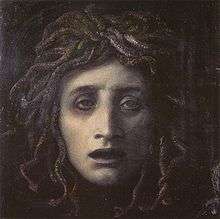
In 1940, Sigmund Freud's "Das Medusenhaupt (Medusa's Head)" was published posthumously. In Freud's interpretation: "To decapitate = to castrate. The terror of Medusa is thus a terror of castration that is linked to the sight of something. Numerous analyses have made us familiar with the occasion for this: it occurs when a boy, who has hitherto been unwilling to believe the threat of castration, catches sight of the female genitals, probably those of an adult, surrounded by hair, and essentially those of his mother."[15] In this perspective the "ravishingly beautiful" Medusa (see above) is the mother remembered in innocence; before the mythic truth of castration dawns on the subject. Classic Medusa, in contrast, is an Oedipal/libidinous symptom. Looking at forbidden mother (in her hair-covered genitals, so to speak) stiffens the subject in illicit desire and freezes him in terror of the Father's retribution. There are no recorded instances of Medusa turning a woman to stone.
Archetypal literary criticism continues to find psychoanalysis useful. Beth Seelig analyzes Medusa's punishment from the aspect of the crime of having been raped rather than having willingly consented in Athena's temple as an outcome of the goddess' unresolved conflicts with her own father, Zeus.[16]
Feminism
too%2C_oil_on_canvas%2C_Judy_Tak%C3%A1cs%2C_2018.jpg)
In the 20th century, feminists reassessed Medusa's appearances in literature and in modern culture, including the use of Medusa as a logo by fashion company Versace.[17][18][19][20] The name "Medusa" itself is often used in ways not directly connected to the mythological figure but to suggest the gorgon's abilities or to connote malevolence; despite her origins as a beauty, the name in common usage "came to mean monster."[21] The book Female Rage: Unlocking Its Secrets, Claiming Its Power by Mary Valentis and Anne Devane notes that "When we asked women what female rage looks like to them, it was always Medusa, the snaky-haired monster of myth, who came to mind ... In one interview after another we were told that Medusa is 'the most horrific woman in the world' ... [though] none of the women we interviewed could remember the details of the myth."[22]
Medusa's visage has since been adopted by many women as a symbol of female rage; one of the first publications to express this idea was a feminist journal called Women: A Journal of Liberation in their issue one, volume six for 1978. The cover featured the image of the Gorgon Medusa by Froggi Lupton, which the editors on the inside cover explained "can be a map to guide us through our terrors, through the depths of our anger into the sources of our power as women."[22]
In issue three, Fall 1986 for the magazine Woman of Power an article called Gorgons: A Face for Contemporary Women's Rage, appeared, written by Emily Erwin Culpepper, who wrote that "The Amazon Gorgon face is female fury personified. The Gorgon/Medusa image has been rapidly adopted by large numbers of feminists who recognize her as one face of our own rage."[22] Griselda Pollock analyses the passage from horrorism to compassion in the figure of the Medusa through Adriana Cavarero's philosophy and Bracha Ettinger's art and Matrixial theory.[23]
Elana Dykewomon's 1976 collection of lesbian stories and poems, They Will Know Me by My Teeth, features a drawing of a Gorgon on its cover. Its purpose was to act as a guardian for female power, keeping the book solely in the hands of women. Stephen Wilk, author of Medusa: Solving the Mystery of the Gorgon, questioned Medusa's enduring status among the feminist movement. He believes that one reason for her longevity may be her role as a protector, fearsome and enraged. "Only the Gorgon has the savage, threatening appearance to serve as an immediately recognized symbol of rage and a protector of women's secrets," wrote Wilk.[24]
Even in contemporary pop culture, Medusa has become largely synonymous with feminine rage. Through many of her iterations, Medusa pushes back against a story that seeks to place the male, Perseus, at its center, blameless and heroic. Author Sibylle Baumbach described Medusa as a “multimodal image of intoxication, petrifaction, and luring attractiveness," citing her seductive contemporary representation, as well as her dimensionality, as the reason for her longevity.[25] Elizabeth Johnston's November 2016 Atlantic essay called Medusa the original 'Nasty Woman.' Johnston goes on to say that as Medusa has been repeatedly compared to Clinton during the 2016 presidential election, she proves her merit as an icon, finding relevance even in modern politics. "Medusa has since haunted Western imagination, materializing whenever male authority feels threatened by female agency," writes Johnston.[26] Beyond that, Medusa's story is, Johnston argues, a rape narrative. A story of victim blaming, one that she says sounds all too familiar in a current American context.
Medusa is widely known as a monstrous creature with snakes in her hair whose gaze turns men to stone. Through the lens of theology, film, art, and feminist literature, my students and I map how her meaning has shifted over time and across cultures. In so doing, we unravel a familiar narrative thread: In Western culture, strong women have historically been imagined as threats requiring male conquest and control, and Medusa herself has long been the go-to figure for those seeking to demonize female authority.
The Medusa story has also been interpreted in contemporary art as a classic case of rape-victim blaming, by the Goddess Athena. Inspired by the #metoo movement, contemporary figurative artist Judy Takács returns Medusa's beauty along with a hashtag stigmata in her portrait, #Me(dusa)too.[27]
Feminist theorist Hélène Cixous famously tackled the myth in her essay "The Laugh of the Medusa." She argues that men's retelling of the narrative turned Medusa into a monster because they feared female desire. "The Laugh of the Medusa" is largely a call to arms, urging women to reclaim their identity through writing as she rejects the patriarchal society of Western culture. Cixous calls writing "an act which will not only 'realize' the decensored relation of woman to her sexuality, to her womanly being, giving her access to her native strength; it will give her back her goods, her pleasures, her organs, her immense bodily territories which have been kept under seal." She claims "we must kill the false woman who is preventing the live one from breathing. Inscribe the breath of the whole woman."[28] Cixous wants to destroy the phallogocentric system, and to empower women's bodies and language.[29] "You only have to look at the Medusa straight on to see her," writes Cixous. "And she's not deadly. She's beautiful and she's laughing."[30]
Nihilism
Medusa has sometimes appeared as representing notions of scientific determinism and nihilism, especially in contrast with romantic idealism.[31][32] In this interpretation of Medusa, attempts to avoid looking into her eyes represent avoiding the ostensibly depressing reality that the universe is meaningless. Jack London uses Medusa in this way in his novel The Mutiny of the Elsinore:[33]
I cannot help remembering a remark of De Casseres. It was over the wine in Mouquin's. Said he: "The profoundest instinct in man is to war against the truth; that is, against the Real. He shuns facts from his infancy. His life is a perpetual evasion. Miracle, chimera and to-morrow keep him alive. He lives on fiction and myth. It is the Lie that makes him free. Animals alone are given the privilege of lifting the veil of Isis; men dare not. The animal, awake, has no fictional escape from the Real because he has no imagination. Man, awake, is compelled to seek a perpetual escape into Hope, Belief, Fable, Art, God, Socialism, Immortality, Alcohol, Love. From Medusa-Truth he makes an appeal to Maya-Lie."
— Jack London, The Mutiny of the Elsinore
Art
_2013_February.jpg)

Medusa has been depicted in several works of art, including:
- Perseus beheading the sleeping Medusa, obverse of a terracotta pelike (jar) attributed to Polygnotos (vase painter) (c. 450 - 440 BC), collection of the Metropolitan Museum of Art
- Medusa on the breastplate of Alexander the Great, as depicted in the Alexander Mosaic from Pompeii's House of the Faun (c. 200 BC)
- Medusa column bases of Basilica Cistern in Constantinople.
- The "Rondanini Medusa", a Roman copy of the Gorgoneion on the aegis of Athena; later used as a model for the Gorgon's head in Antonio Canova's marble Perseus with the Head of Medusa (1798–1801)
- Medusa (oil on canvas) by Leonardo da Vinci
- Perseus with the Head of Medusa (bronze sculpture) by Benvenuto Cellini (1554)
- Perseus and Medusa – bronze statue by Hubert Gerhard (c. 1590)
- Medusa (oil on canvas) by Caravaggio (1597)
- Head of Medusa, by Peter Paul Rubens (1618)
- Medusa (marble bust) by Gianlorenzo Bernini (1630s)
- Medusa is played by a countertenor in Jean-Baptiste Lully and Philippe Quinault's opera, Persée (1682). She sings the aria "J'ay perdu la beauté qui me rendit si vaine" ("I have lost the beauty that made me so vain").
- Perseus Turning Phineus and his Followers to Stone (oil on canvas) by Luca Giordano (early 1680s).
- Perseus with the Head of Medusa (marble sculpture) by Antonio Canova (1801)
- Medusa (1854), marble sculpture by Harriet Hosmer, collection of the Detroit Institute of Art
- Medusa (oil on canvas) by Arnold Böcklin (c. 1878)
- Perseus (bronze sculpture) by Salvador Dalí
- Medusa sculpture by Luciano Garbati, which portrays her clutching the severed head of Perseus (2008) [34]
Medusa remained a common theme in art in the nineteenth century, when her myth was retold in Thomas Bulfinch's Mythology. Edward Burne-Jones' Perseus Cycle of paintings and a drawing by Aubrey Beardsley gave way to the twentieth century works of Paul Klee, John Singer Sargent, Pablo Picasso, Pierre et Gilles, and Auguste Rodin's bronze sculpture The Gates of Hell.[35]
Film
The most influential depiction of Medusa in film is arguably the stop motion animation created by Ray Harryhausen for Clash of the Titans (1981). As well has having snakes for hair, she was given a serpent-like body and rattlesnake-like tail. The model was one Harryhausen’s most complex and in 2020 it was voted third favourite among his many creations.
Flags and emblems
The head of Medusa is featured on some regional symbols. One example is that of the flag and emblem of Sicily, together with the three legged trinacria. The inclusion of Medusa in the center implies the protection of the goddess Athena, who wore the Gorgon's likeness on her aegis, as said above. Another example is the coat of arms of Dohalice village in the Czech Republic.
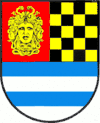
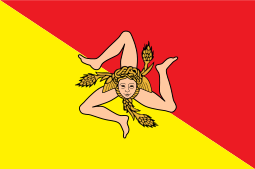
 Ceremonial French military uniform belt of World War I
Ceremonial French military uniform belt of World War I
Science
Medusa is honored in the following scientific names:[36]
- Acanthemblemaria medusa Smith-Vaniz & Palacio 1974
- Apodochondria medusae Ho & Dojiri 1988
- Archimonocelis medusa Curini-Galletti & Cannon 1997
- Atractus medusa Passos et al. 2009[37]
- Australomedusa Russell 1970
- Boeromedusa Bouillon 1995
- Bothrops medusa Sternfeld 1920[37]
- Caput medusae
- Cardiodectes medusaeus Wilson C.B. 1908
- Chama oomedusae Matsukuma 1996
- Cirratulus medusa Johnston 1833
- Coronamedusae
- Csiromedusa Gershwin & Zeidler 2010
- Csiromedusa medeopolis Gershwin & Zeidler 2010
- Discomedusa lobata Claus 1877
- Discomedusae
- Eustomias medusa Gibbs, Clarke & Gomon 1983
- Gorgonocephalus caputmedusae L. 1758
- Gyrocotyle medusarum von Linstow 1903 (taxon inquirendum)
- Halimedusa Bigelow 1916
- Halimedusa typus Bigelow 1916
- Heteronema medusae Skvortzov 1957
- Hoplopleon medusarum K.H. Barnard 1932
- Hyperia medusarum Müller 1776
- Hyperoche medusarum Krøyer 1838
- Leptogorgia medusa Bayer 1952
- Lilyopsis medusa Metschnikoff & Metschnikoff 1871
- Limnomedusae
- Loimia medusa Savigny in Lamarck 1818
- Loimia medusa angustescutata Willey 1905
- Lulworthia medusa (Ellis & Everh.) Cribb & J.W. Cribb 1955
- Lulworthia medusa var. biscaynia Meyers 1957
- Lulworthia medusa var. medusa (Ellis & Everh.) Cribb & J.W. Cribb 1955
- Magnippe caputmedusae Stock 1978
- Medusa Loureiro 1790
- Medusablennius Springer 1966
- Medusafissurella McLean & Kilburn 1986
- Medusafissurella chemnitzii G. B. Sowerby I 1835
- Medusafissurella dubia Reeve 1849
- Medusafissurella melvilli G. B. Sowerby III 1882
- Medusafissurella salebrosa Reeve 1850
- Mesacanthoides caputmedusae (Ditlevsen 1918) Wieser 1959
- Myxaster medusa Fisher 1913
- Narcomedusae
- Ophioplinthus medusa Lyman 1878
- Phallomedusa Golding, Ponder & Byrne 2007
- Phallomedusa austrina Golding, Ponder & Byrne 2007
- Phallomedusa solida Martens 1878
- Phascolion medusae Cutler & Cutler 1980
- Philomedusa
- Philomedusa vogtii Müller 1860
- Polycirrus medusa Grube 1850
- Polycirrus medusa sakhalinensis Buzhinskaja 1988
- Sarcomella medusa Schmidt 1868
- Stauromedusae
- Stellamedusa Raskoff & Matsumoto 2004
- Stellamedusa ventana Raskoff & Matsumoto 2004
- Stygiomedusa Russell 1959
- Stygiomedusa gigantea Browne 1910
- Thylacodes medusae Pilsbry 1891
- Trachymedusae
In popular culture
The petrifying image of Medusa makes an instantly recognizable feature in popular culture. Medusa has been featured in several works of fiction, including video games, movies, cartoons and books. In particular, the designer Versace's symbol is reflected through the Medusa-head symbol. It was chosen because she represents beauty, art, and philosophy.[38]
The motive of the Medusa has also had an appearance in some of the modern songs. One of the most notable examples is the song 'Medusa' by the American thrash metal band Anthrax, which describes this demonic creature and is the ninth track on their second studio album Spreading the Disease.
See also
- Apotropaic symbols
- Caput Medusae
- Euryale
- Medea
- Medusa complex
- Stheno
- Theodontius
- Tiamat
- Humbaba
Notes and references
- Probably the feminine present participle of medein, "to protect, rule over" (American Heritage Dictionary; compare Medon, Medea, Diomedes, etc.). If not, it is from the same root, and is formed after the participle. OED 2001 revision, s.v.; medein in LSJ.
- as in Hesiod, Theogony 270, and Pseudo-Apollodorus Bibliotheke, 1.10.
- "From Gorgon and Ceto, Sthenno, Euryale, Medusa".
- Bullfinch, Thomas. "Bulfinch Mythology – Age of Fable – Stories of Gods & Heroes". Retrieved 2007-09-07.
...and turning his face away, he held up the Gorgon's head. Atlas, with all his bulk, was changed into stone.
- (Pythian Ode 12). Noted by Marjorie J. Milne in discussing a red-figured vase in the style of Polygnotos, ca. 450–30 BC, in the Metropolitan Museum of Art; Milne noted that "It is one of the earliest illustrations of the story to show the Gorgon not as a hideous monster but as a beautiful woman. Art in this respect lagged behind poetry." (Marjorie J. Milne, "Perseus and Medusa on an Attic Vase" The Metropolitan Museum of Art Bulletin New Series, 4.5 (January 1946, pp. 126–130) 126.p.)
- Philip Freeman (2013). Oh My Gods: A Modern Retelling of Greek and Roman Myths. p. 30. ISBN 9781451609981.
- Hesiod, Theogony 281; Pseudo-Apollodorus, Bibliotheke 2. 42, et al. Harris, Stephen L. and Gloria Platzner. Classical Mythology: Images and Insights. 2nd ed. (New York: Mayfield Publishing), 1998. 234.
- Harrison, p. 187.
- Roger Lancelyn Green suggests in his Tales of the Greek Heroes written for children that Athena used the aegis against Atlas.
- Smith, "Perseus".
- "the definition of quasihistorical". Dictionary.com. Retrieved 2017-05-24.
- Graves, Robert (1955). The Greek Myths. Penguin Books. pp. 17, 244. ISBN 0241952743.
A large part of Greek myth is politico-religious history. Bellerophon masters winged Pegasus and kills the Chimaera. Perseus, in a variant of the same legend, flies through the air and beheads Pegasus's mother, the Gorgon Medusa; much as Marduk, a Babylonian hero, kills the she-monster Tiamat, Goddess of the Seal. Perseus's name should properly be spelled Perseus, 'the destroyer'; and he was not, as Professor Kerenyi has suggested, an archetypal Death-figure but, probably, represented the patriarchal Hellenes who invaded Greece and Asia Minor early in the second millennium BC, and challenged the power of the Triple-goddess. Pegasus had been sacred to her because the horse with its moon-shaped hooves figured in the rain-making ceremonies and the installment of sacred kings; his wings were symbolical of a celestial nature, rather than speed.
Jane Harrison has pointed out (Prolegomena to the Study of Greek Religion) that Medusa was once the goddess herself, hiding behind a prophylactic Gorgon mask: a hideous face intended to warn the profane against trespassing on her Mysteries. Perseus beheads Medusa: that is, the Hellenes overran the goddess's chief shrines, stripped her priestesses of their Gorgon masks, and took possession of the sacred horses—an early representation of the goddess with a Gorgon's head and a mare's body has been found in Boeotia. Bellerophon, Perseus's double, kills the Lycian Chimaera: that is, the Hellenes annulled the ancient Medusan calendar, and replaced it with another. - Ellen Harrison, Jane (June 5, 1991) [1908]. Prolegomena: To The Study Of Greek Religion. Princeton, New Jersey: Princeton University Press. pp. 187–188. ISBN 0691015147.
- Campbell, Joseph (1968). The Masks of God, Vol. 3: Occidental Mythology. London: Penguin Books. pp. 152–153. "We have already spoken of Medusa and of the powers of her blood to render both life and death. We may now think of the legend of her slayer, Perseus, by whom her head was removed and presented to Athene. Professor Hainmond assigns the historical King Perseus of Mycenae to a date c. 1290 B.C., as the founder of a dynasty, and Robert Graves–whose two volumes on The Greek Myths are particularly noteworthy for their suggestive historical applications–proposes that the legend of Perseus beheading Medusa means, specifically, that "the Hellenes overran the goddess's chief shrines" and "stripped her priestesses of their Gorgon masks", the latter being apotropaic faces worn to frighten away the profane. That is to say, there occurred in the early thirteenth century B.C. an actual historic rupture, a sort of sociological trauma, which has been registered in this myth, much as what Freud terms the latent content of a neurosis is registered in the manifest content of a dream: registered yet hidden, registered in the unconscious yet unknown or misconstrued by the conscious mind. And in every such screening myth–in every such mythology {that of the Bible being, as we have just seen, another of the kind}–there enters in an essential duplicity, the consequences of which cannot be disregarded or suppressed.". ISBN 978-0140194418.
- Freud, Sigmund (Summer 2017). "Medusa's Head". The Standard Edition of the Complete Psychological Works of Sigmund Freud. The Hogarth Press. XVIII: 273.
- Seelig, B.J. (2002). "The Rape of Medusa in the Temple of Athena: Aspects of Triangulation". International Journal of Psycho-Analysis, 83:895–911.
- "Versace Medusa Head Logo". gevrilgroup.com.
- Pratt, A. (1994). Archetypal empowerment in poetry: Medusa, Aphrodite, Artemis, and bears : a gender comparison. Bloomington: Indiana University Press. ISBN 0-253-20865-3
- Stephenson, A. G. (1997). "Endless the Medusa: a feminist reading of Medusan imagery and the myth of the hero in Eudora Welty's novels."
- Garber, p. 7.
- Garber, p. 1.
- Wilk, pp. 217–218.
- Griselda Pollock, "From Horrorism to Compassion" in G. Pollock (ed.) Visual Politics of Psychoanalysis, London: I.B.Tauris, 2013. ISBN 978-1-78076-316-3
- Wilk, Stephen (2000). Medusa: Solving the Mystery of the Gorgon. New York: Oxford University Press. p. 219.
- Hastings, Christobel. "The Timeless Myth of Medusa, a Rape Victim Turned Into a Monster". Broadly. Vice. Retrieved 5 December 2018.
- Johnston, Elizabeth. "The Original 'Nasty Woman'". The Atlantic. Retrieved 5 December 2018.
- Takács, Judy (September 30, 2018). "#Me(dusa)too". chickswithballsjudytakacs.blogspot.com. Retrieved February 25, 2020.
- Cixous, Helene. "The Laugh of the Medusa" (PDF). Retrieved 5 December 2018.
- Klages, Mary (2006). Literary Theory: A Guide for the Perplexed. New York, NY: Continuum International Publishing Group. p. 99.
- Cixous, Helene. "The Laugh of the Medusa" (PDF). Retrieved 5 December 2018.
- "Medusa in Myth and Literary History". Retrieved 2010-01-06.
- Petersen, Per Serritslev. "Jack London's Medusa of Truth." Philosophy and Literature 26.1 (2002). pp. 43–56.
- London, p. 121.
- "Luciano Garbati's Medusa". Luciano Garbati.
- Wilk, p. 200.
- WoRMS Editorial Board (2017). World Register of Marine Species. Available from http://www.marinespecies.org at VLIZ. Accessed 2017-09-06. doi:10.14284/170
- Beolens, Bo; Watkins, Michael; Grayson, Michael (2011). The Eponym Dictionary of Reptiles. Baltimore: Johns Hopkins University Press. xiii + 296 pp. ISBN 978-1-4214-0135-5. ("Medusa", p. 175).
- "Archived copy". Archived from the original on 2012-02-15. Retrieved 2012-01-27.CS1 maint: archived copy as title (link)
Primary sources
- Servius, In Aeneida vi.289
- Lucan, Bellum civile ix.624–684
- Ovid, Metamorphoses iv.774–785, 790–801
Secondary sources
- Garber, Marjorie, Vickers, Nancy, The Medusa Reader, Routledge; 1 edition (February 26, 2003), ISBN 978-0-415-90099-7.
- Harrison, Jane Ellen (1903) 3rd ed. 1922. Prolegomena to the Study of Greek Religion,: "The Ker as Gorgon"
- London, Jack (1914). The Mutiny of the Elsinore. ISBN 0-935180-40-0.
- Smith, William; Dictionary of Greek and Roman Biography and Mythology, London (1873). "Perseus"
- Wilk, Stephen R. (2007). Medusa: Solving the Mystery of the Gorgon. Oxford University Press. ISBN 978-0-19-534131-7
- Walker, Barbara G. (1996). The Women's Encyclopedia of Myths & Secrets. New Jersey: Castle Books. ISBN 0785807209 .
External links
| Wikimedia Commons has media related to Medusa. |
- Ancient coins depicting Medusa
- "Medusa in Myth and Literary History" – English.uiuc.edu
- On the Medusa of Leonardo da Vinci in the Florentine Gallery, by Percy Bysshe Shelley
- Theoi Project, Medousa & the Gorgones References to Medusa and her sisters in classical literature and art